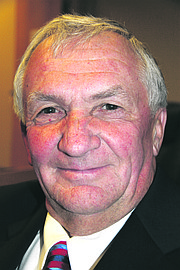Hayden hesitates in re-entry debate
Late last month, a 31-year-old walked away from the women’s prison re-entry facility in Boise, a stately domicile that resembles a retirement home on East Penitentiary Road.
Kori Kathleen Freeland, who was eligible for parole in December after being convicted of forgery and a drug charge, walked away from her job before 10 p.m. and was found the next day 35 miles away in Mountain Home. She was arrested without incident.
She is the only inmate to walk away from a prison re-entry facility this year, said Jeff Ray of the Idaho Department of Correction.
But they do happen. Six inmates walked away from the state’s four re-entry centers last year.
“They have shown they will walk away,” Hayden City Council member Matt Roetter said.
In a presentation to the Hayden council Tuesday night, Roetter stated why a re-entry facility, like the $12 million project being proposed for North Idaho, is not a good fit for Hayden.
Roetter presented to the City Council a draft resolution to sink any proposals by the state to build a prisoner pre-release facility within the city limits of the lakeside community.
But the council, fearing Roetter’s resolution would show bias, opted to research further the intent of the Idaho Department of Correction, which says it is looking for a North Idaho location for its latest re-entry center.
The Legislature at its last session allocated $12.2 million for a North Idaho facility.
Josh Tewalt, director of IDOC, said the state’s proposed pre-release center could house between 100 and 130 Panhandle inmates. It would provide them with counseling, job opportunities, daily drug testing and a softer re-entry into society to reduce the chance for recidivism.
The department has four facilities in southern Idaho, and is building another one in Twin Falls scheduled to open next year. But because a significant portion of the state’s inmates are from North Idaho, having a facility in the Kootenai metro area makes sense to the department and the Legislature.
“We’re trying to do it because we think it will help people transition successfully into the community,” Tewalt said. “Our intent is to put the resources where they’re needed.”
The center, Tewalt said, will not house sex offenders or violent criminals. The beds are reserved for inmates on a competitive basis. Only inmates with the best track records need apply.
“I understand the fear,” he said.
But there are upsides for communities, including a labor force and an economic boost.
Yet, Tewalt said, no facility will land where it is not wanted.
Communities in southern and southeastern Idaho where facilities exist have worked through misconceptions and welcomed the re-entry centers, he said.
“Communities in North Idaho may decide this isn’t the right fit, and that’s OK,” he said. “These centers have to be embraced by local communities because we are not interested in building one if it’s not going to be successful. That’s counterproductive.”
Roetter, who was instrumental in stopping an attempt by IDOC to build a re-entry center in 2001 in Hayden, isn’t convinced the department will not find land to build a center where it deems necessary.
John Cafferty, Hayden’s attorney, said the state could bypass city rules. State law allows the government — federal, state, county or city — to build in light industrial zones without an entity’s blessing.
Although Roetter’s resolution to throw a roadblock in the path of the IDOC was not acted upon Tuesday, council members left the door open to consider it at another time.
“If we do it we better do it correctly,” council member Dick Panabaker said.
Tewalt says his department can wait.
“There’s no clock on it,” he said.



